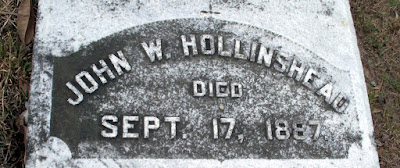Anna E. Hollinshead died 5 February 1913 and was laid to rest in Oaklawn Cemetery at Fort Valley, Houston (later Peach) County, Georgia. On 20 November 1911, she signed her last will and testament. In it, she instructed her executor to erect monuments over the graves of her two siblings and mother "should I not, during my lifetime."
Should I not, during my lifetime, erect over the graves of W. E. Brown and his wife, Mrs. Emma Brown, a monument, then I hereby instruct my executor to have erected over their graves a suitable monument at a cost not to exceed One Hundred & Fifty Dollars, which sum I authorize him to employ for that purpose.
Emma Hollinshead Brown died 12 October 1906, and Walter Edward Brown died 1 March 1899. This was, respectively, five and twelve years before the signed last will and testament of Anna.
I also authorize and instruct my said executor to have erected over the grave of my mother, Mrs. Nancy Jane Hollinshead...
Mother Hollinshead died 28 October 1880, thirty-one years before Anna's last will and testament.
...and over the grave of my deceased brother, John W. Hollinshead, monuments, the two not to exceed One Hundred Dollars in cost, which sum I authorize him to have used for that purpose.
John Hollinshead died 17 September 1887, twenty-four years before Anna's will.
I also authorize him to place a coping around the lot on which these graves are situated and a suitable mark over my grave at a cost which I leave to his discretion.





Comments